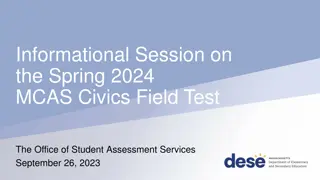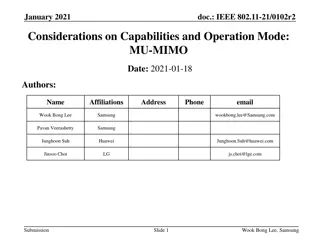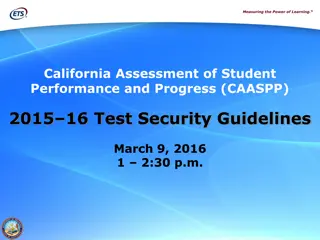
Injury Recovery, Plankton Digestibility, Celestial Instruments - Quiz
Explore important topics including injury recovery techniques, plankton digestibility, celestial instruments, historical events, and military alliances in this engaging quiz.
Download Presentation

Please find below an Image/Link to download the presentation.
The content on the website is provided AS IS for your information and personal use only. It may not be sold, licensed, or shared on other websites without obtaining consent from the author. If you encounter any issues during the download, it is possible that the publisher has removed the file from their server.
You are allowed to download the files provided on this website for personal or commercial use, subject to the condition that they are used lawfully. All files are the property of their respective owners.
The content on the website is provided AS IS for your information and personal use only. It may not be sold, licensed, or shared on other websites without obtaining consent from the author.
E N D
Presentation Transcript
1. _______minutes every two to three hours for the first 2-3 days after the injury. For maximum recovery, from a muscle, joint, or bone injury, apply an ice pack for a) 10-15 b) 15-20 c) 5-10 d) 20-30
2. Because plankton can be hard to digest, you should_________. a) start off by eating only small amounts b) grind it into a fine powder before eating it c) not eat it. d) dry it before eating it
3. What instrument is used to obtain celestial sights? a) Sextant b) Chronometer c) Fathometer d) Stadimeter
4. In general, the United States has condemned the use of Chemical, Biological, and Nuclear (CBR) weapons, and President __________ halted the production of chemical and biological agents in 1969. a) John F. Kennedy b) Richard M. Nixon c) Lyndon B. Johnson d) James Carter
5. Geosynchronous satellites, hovering ____________ miles above the equator at a fixed location, photograph an entire hemisphere every half an hour. a) 2300 b) 9000 c) 22300 d) 900
6. The post-war military alliances which were formed by the Western democracies on the one hand, and the Soviet-controlled states on the other, were, respectively, the a) Marshall Plan and Warsaw Pact. b) Eastern Europe Mutual Assistance Treaty and North Atlantic Treaty Organization. c) North Atlantic Treaty Organization and the Warsaw Pact. d) European Recovery Program and Council for Mutual Economic Assistance.
7. Admiral King's first instructions to Admiral Nimitz after he took command as the Commander and Chief of the Pacific Fleet were to cover and hold the Hawaii-Midway line and to maintain communications between the West Coast and a) Guam b) Samoa c) Australia d) The Aleutian Islands
8. What physical conditions were most important to the planners of the Normandy invasion? a) Layout and design of the landing areas b) Weather, visibility and tides c) Security of the plan of invasion d) Availability of German reinforcements
9. The scientific term used to describe how much of a material is present per unit of its volume is __________. a) Density b) Gravity c) Apparent weight d) Waterline
10. The most intense and violent of localized storms is the a) typhoon. b) tropical cyclone. c) tornado. d) hurricane.
11. This particular need includes protection from threats, violence disease, or poverty. a) Belonging b) Esteem c) Physical d) Security
12. The feeling of physical and emotional well-being after exercising is partly the result of the body's production of what substance? a) Adrenalin b) Insulin c) Melatonin d) Endorphins
13. What is the final stage of a thunderstorm called? a) Altocumulus b) Cumulus c) Dissipating or anvil d) Mature
14. differences. __________________is key to breaking down the barriers and accepting others' a) Good Communication b) Demonstrating tolerance c) Gender stereotyping d) Common goals
15. The introduction to the Declaration of Independence, which announces the plan to separate from the British Empire, is known as the _______. a) preface b) prologue c) prelude d) preamble
16. We refer to an ____________________as a promotion, as in rank. a) Profession b) Career c) Occupation d) Advancement
17. Motivation in the Navy can directly affect a) All of the answers are correct. b) morale. c) reenlistment. d) readiness.
18. The U.S. must import what % of its oil requirements? a) 40% b) 20% c) 80% d) 60%
19. Boundaries of air masses of different temperatures that collide are called a) slopes. b) areas. c) fronts. d) zones.
20. Fog that is caused by the evaporation of precipitation in December and January is called a) steam fog. b) common fog. c) frontal fog. d) coastal fog
21. What term is used to refer to exercise in which adequate amounts of oxygen are not being delivered to the muscles? a) Anaerobic b) Isokinetic c) Aerobic d) Isometric
22. A team member's _______is a combination of the knowledge, experience, and skill that he/she brings to a task. a) readiness b) willingness c) ability d) confidence
23. The Ukrainians have a fleet of naval warships based at Sevastopol on the a) Black Sea. b) North Sea. c) Red Sea. d) Caribbean Sea.
24. In what year did France formally join America in her battle for independance? a) 1782 b) 1785 c) 1778 d) 1775
25. Another name for manic-depressive illness is _______disorder. a) panic b) fatigue c) bipolar d) anxiety






















